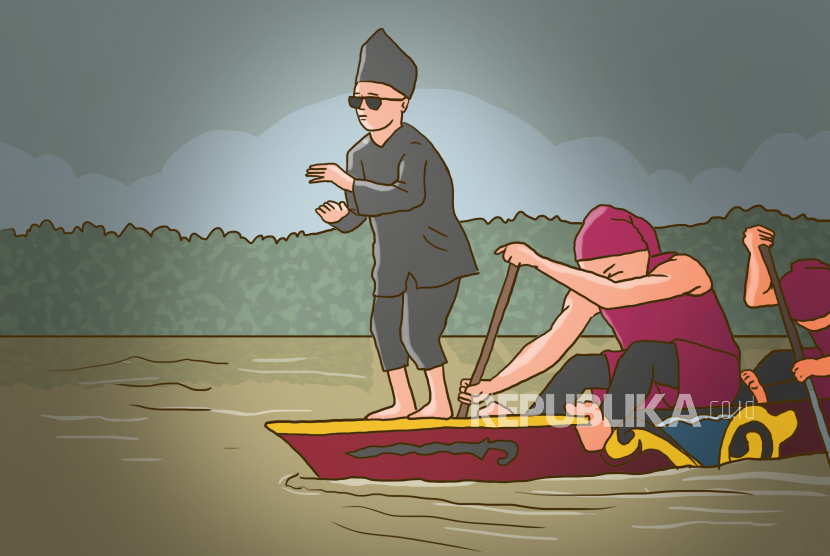Judul : The Pacu Jalur Tradition Does Not Belong to Malaysia or Vietnam, But to Indonesia, Here Are the Evidence
link : The Pacu Jalur Tradition Does Not Belong to Malaysia or Vietnam, But to Indonesia, Here Are the Evidence
The Pacu Jalur Tradition Does Not Belong to Malaysia or Vietnam, But to Indonesia, Here Are the Evidence

Best for you.CO.ID, JAKARTA -- The tradition of "pacu jalur" in Kuantan Singingi Regency went viral on social media. One thing that made it go viral was the act of a child dancing at the end of the boat to encourage the rowers.
However, in the virtual world, the tradition has sparked controversy regarding its cultural origin."Pacu jalur from Malaysia," said a netizen.
" Its trend from Vietnam, not trend from Indonesia . Proud Vietnamese culture ," wrote other netizens.
Some also mention from the Philippines and Thailand. It is claimed that in the Philippines, adults used to dance before, but because the boat was more slender, it was replaced by children.
However, Culture Minister Fadli Zon stated that the Pacu Jalur tradition in Kuantan Singingi Regency, Riau Province, belongs to Indonesia. This tradition has been registered as a national intangible cultural heritage.
Pacu Jalur is a traditional canoe racing event, which has recently become a viral trend on the short video sharing platform TikTok.
"The Ministry of Culture has also recorded it as a national intangible cultural heritage, so it is called WBTB Indonesia, so it has been a long time," he said in Jakarta on Tuesday.
The Minister of Culture stated that the traditional sports competition in Kuantan Singingi is part of Indonesia's cultural wealth. He also mentioned that the dance performed by the Pacu Jalur team members as the boat moves is expressive and attractive.
"According to me, it's organic, expressive, adapting to the rhythm of the pace while performing an attractive movement. It's a difficult act. It's difficult, at the end of the boat, so balance is very important," he said.
The Minister of Culture appreciated all parties who contributed to promoting the cultural wealth of Nusantara to the world community through various platforms, including through social media.
Quoted from the Kuantan Singingi government website, Pacu Jalur is a People's Festival that is the pride of Kuantan Singingi Regency's community. The history of Pacu Jalur began in the 17th century.
Initially, the "pacu jalur" was the main means of transportation for the villagers in Rantau Kuantan, which is an area along the Kuantan River, located between Hulu Kuantan District in the upper part and Cerenti District in the lower part.
At that time, land transportation had not yet developed. As a result, the route was truly used as an important means of transport for villagers, especially used as a means of transporting agricultural products, such as bananas and sugarcane, and also functioned to transport about 40-60 people.
Then emerged the decorated lines, such as carvings of snake heads, crocodile, or tiger, both on the hull and the stern, plus the umbrella equipment, ropes, sashes, central poles (gulang-gulang) and banners (where the pilot stands).
These changes also marked the development of the road's function, no longer merely a means of transportation, but also indicating social identity. Because only regional rulers, nobles, and elders drove those decorated roads.
Only after 100 years, the residents saw another side that made the existence of the path increasingly interesting, namely by holding a speed racing event between the paths, which is still known today as Pacu Jalur.
Initially, Pacu Jalur was held in villages along the Kuantan River to commemorate major Islamic holidays. However, with the development of the times, eventually Pacu Jalur was held to commemorate the Independence Day of the Republic of Indonesia. Therefore, Pacu Jalur is held around August.
It can be described as during the Pacu Jalur day, the city of Jalur is like an ocean of people. Traffic jams occur everywhere, and people from the diaspora will appear again, they will return only to watch this event. Usually, the lanes following the race can reach more than 100. According to the local community, the lane is a "big boat" made of solid wood without joints, with a capacity of 45-60 rowers (child pacu).
This race, which is said to have existed since 1903, has become a regular event of the Riau Provincial Government to attract domestic and foreign tourists to visit Riau, especially in Kuantan Singingi Regency.
During the Dutch colonial era, Pacu Jalur was held to enliven traditional celebrations, community feasts, and to commemorate the birthday of Queen Wilhelmina, which fell on August 31.
The Pacu Jalur event during the Dutch era started on August 31 to September 1 or 2. The Pacu Jalur celebration was held as a competition for 2-3 days, depending on the number of lanes participating in the race.
Demikianlah Artikel The Pacu Jalur Tradition Does Not Belong to Malaysia or Vietnam, But to Indonesia, Here Are the Evidence
Anda sekarang membaca artikel The Pacu Jalur Tradition Does Not Belong to Malaysia or Vietnam, But to Indonesia, Here Are the Evidence dengan alamat link https://www.punyakamu.com/2025/07/the-pacu-jalur-tradition-does-not.html
0 Response to "The Pacu Jalur Tradition Does Not Belong to Malaysia or Vietnam, But to Indonesia, Here Are the Evidence"
Post a Comment